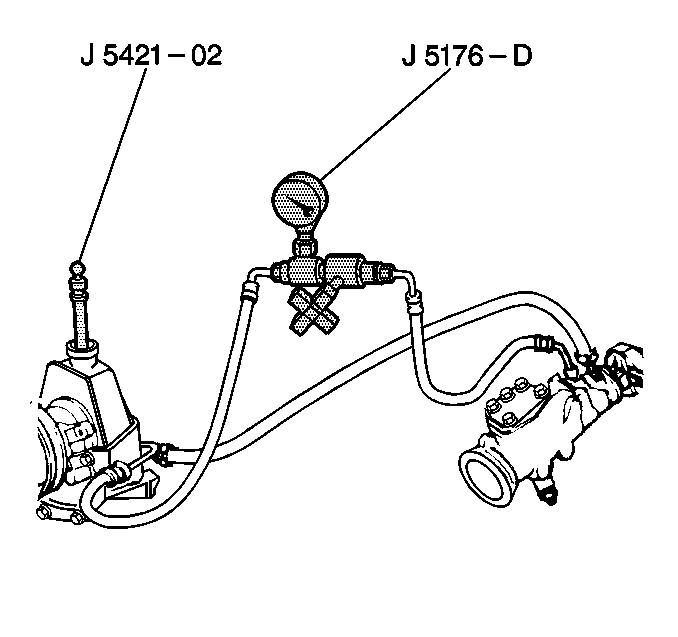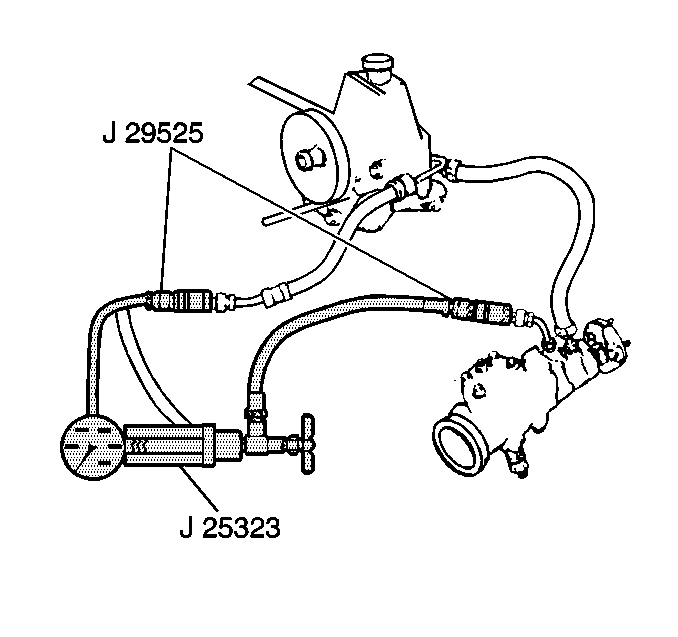Tools Required
| • | J 5176-E Power
Steering Pressure Tester |
| • | J 29525 Power
Steering Analyzer Adapter (18 mm) |

Test the power steering
system using either the J 5176-E
or the J 25323-D
.

The J 25323-D
will
measure the flow rate in addition to the pressure.
The power steering system test identifies and isolates hydraulic circuit
difficulties. Perform the following inspections and corrections, as needed,
prior to performing the power steering system test:
| • | Inspect the reservoir for the proper fluid level. |
| • | Inspect the pump belt for the proper tension. |
| • | Inspect the tires for the correct air pressure. |
| • | Inspect the power steering system. |
| • | Replace the components as needed. |
Test with J 5176-E
Important: All tests are made with the engine idling at the normal operating temperature.
Inspect the idle speed adjustment. Adjust the idle speed to the correct specification,
as needed.
- Place a container under the steering gear or the pump in order
to catch the fluid when disconnecting or connecting the hoses.
- Turn OFF the engine.
- Disconnect the pressure hose at the steering gear or the steering
pump.
- Use the adapter fitting J 5176-20A
in order to install the J 5176-E
to both of the hoses.
- Ensure that the gauge is between the shut off valve and the pump.
- Open the shut off valve.
- Remove the filler cap from the pump reservoir.
- Inspect the fluid level.
Fill the pump reservoir with the power steering fluid to the full mark
on the dipstick.
- Start the engine.
Notice: Do not hold the steering wheel in the full turn position longer than
five seconds. To do so may damage the power steering pump.
- Momentarily hold the steering wheel against the stop.
Inspect the connections at the J 5176-E
for leakage.
- Bleed the system. Refer to
Power Steering System Bleeding
.
Important: In order to prevent scrubbing flat spots on the tires, do not turn the
steering wheel more than 5 times without rolling the vehicle in order
to change the tire-to-floor contact area.
- Insert the J 5421-02
thermometer into the reservoir filler opening.
- Move the steering wheel from stop to stop several times until
the thermometer indicates a hydraulic fluid temperature in the reservoir of
65-77°C (150-170°F).
- Inspect the pump fluid level.
- Add power steering fluid as needed.
When the engine is at the normal operating temperature, the initial
pressure on the gauge (with the valve open), should be in the 550-860 kPA
(80-125 psi) range. If the pressure is in excess of 1380 kPa
(200 psi), inspect the hoses for restrictions. Inspect the poppet
valve for proper assembly.
- Fully open and close the gauge valve 3 times.
Record the highest pressures that you attain each time.
- The pump is functioning within the specifications if the following
conditions occur:
| • | The pressures are within the specifications at the end of this
portion of the test. |
| • | The range of the readings is within 345 kPa (50 psi). |
| • | The pressures are high, but each reading repeats the same pressures
within 345 kPa (50 psi). |
- If the pressures are high, but do not repeat within 345 kPa
(50 psi), the flow control valve is sticking. If the flow control valve
is sticking, perform the following procedure:
| 18.1. | Remove the flow control valve. |
| 18.2. | Clean the flow control valve. |
| 18.3. | Use a crocus cloth or a fine hone in order to remove any burrs. |
| 18.4. | Flush the system if the system contains some dirt. If the system
is exceptionally dirty, perform the following tasks to both the pump and the
gear: |
| 18.5. | Completely flush the fluid reservoir before any further use. |
- If the pump checks within the specifications, leave the valve
open.
- Turn the steering wheel to both stops.
Record the highest pressures.
Compare the pressures with the maximum pump pressure that is recorded.
If this pressure cannot build in either (or 1) side of the gear, the
gear is leaking internally. Disassemble and repair the gear.
- Turn OFF the engine.
- Remove the testing gauge.
- Reconnect the pressure hose.
- Inspect the fluid lever and/or make the necessary repairs.
- If the problem still exists, examine the steering and the front
suspension. Refer to the appropriate power steering system diagnostic procedure.
Testing with J 25323-D
- Place a container under the steering gear or the pump in order
to catch the fluid when disconnecting or connecting the hoses.
- Turn OFF the engine.
- Disconnect the pressure hose at the steering gear or the power
steering pump.
- Use the J 29525
adapter.
Thread the female adapter into the pressure hose.
Thread the male adapter into the gear or the pump.
Connect the J 25323-D
hoses to the adapters.
- If the J 25323-D
has never been used, bleed the power steering system in order to remove
all of the air. Refer to
Power Steering System Bleeding
.
The analyzer gate must be open during this procedure.
- Add power steering fluid to the pump or the reservoir if needed.
- Run the engine at idle speed with the gate valve open.
- Record the flow (A) and the pressure (B).
| • | If the flow is below 1.4 L/min (2 gpm) the pump
may need repair. Continue the test before making any repairs. |
| • | If the pressure is above 1035 kPa (150 psi) inspect
the hoses for restrictions. Inspect the steering gear. |
- Partially close the gate valve in order to build to 4278 kPa
(620 psi).
Record the flow (C).
- If the flow (C) drops more than 3.7 L/min (1 gpm)
under flow (A), disassemble the pump. Replace the following items:
- Replace the pressure plates if the plates are worn or have cracks.
- Replace all of the O-rings when reassembling the pump.
- Continue the test.
- Completely close and partially open the gate valve 3 times.
Record the gate-closed pressure (D).
- Inspect the pressure specifications at the end of this portion
of the test.
| • | If the pump pressure is 690 kPa (100 psi) lower
than the minimum specification listed, replace the flow control valve in the
pump. |
| • | If the recorded pressure is above the maximum specification listed,
perform the following tasks to the flow control valve in the pump: |
| - | Replace the valve, if needed. |
| • | Completely disassemble and clean the following components before
any further use: |
| • | Completely flush the fluid reservoir before any further use. |
- Increase the engine speed from idle to approximately 1500 RPM.
Record the flow (E).
- If the flow (E) varies more than 3.7 L/min (1 gpm)
from flow (A), perform the following procedure on the flow control
valve:
| • | Replace the valve, if needed. |
Notice: Do not hold the steering wheel in the full turn position longer than
five seconds. To do so may damage the power steering pump.
- Turn the steering wheel lightly against both of the stops. Record the
pressure and the flow (F).
| • | The pressure that develops at both of the stops should be nearly
the same as the maximum pump output (D). At the same time, the flow
should drop below 1.85 L/min (0.5 gpm). |
| • | If the pressure does not reach the maximum output, or if the flow
does not drop below the specified value, excessive internal leakage is occurring. |
| • | Remove and disassemble the steering gear. |
- Turn the steering wheel in both directions. Quickly release the
steering wheel while watching the pressure gauge. The needle should move from
the normal pressure reading and snap back as you release the wheel.
If the steering wheel moves back slowly or sticks, the rotary valve
in the steering gear is sticking. Perform the following procedure to the rotary
valve:
| 19.3. | Replace the valve, if needed. |
- If the system contains a lot of dirt and foreign materials perform
the following operations:
- Completely flush the fluid reservoir before any further use.
- If the problem still exists, thoroughly examine the steering and
the front suspension. Refer to the appropriate power steering system diagnostic
procedure.


